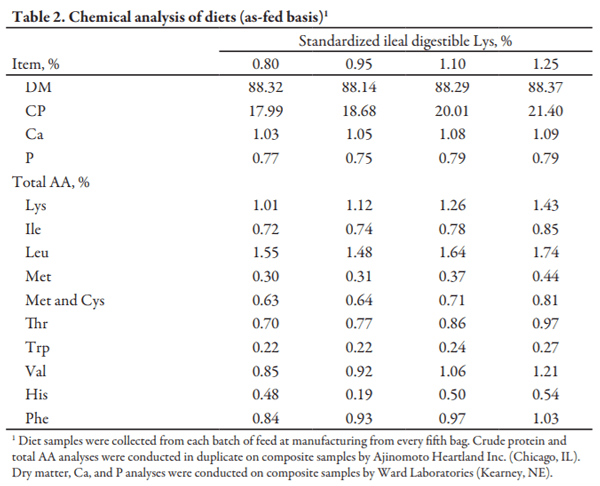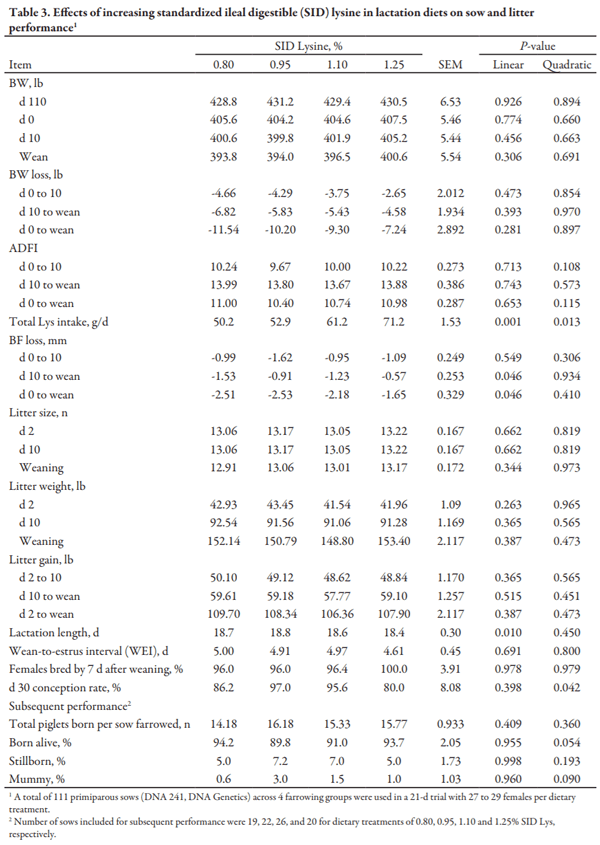Introduction
Lysine is the first limiting amino acid in corn-soybean meal-based swine diets. In order to maximize efficiency in all stages of production, the requirement of Lys needs to be determined. In lactation diets, nutrients need to be supplied to support both sow maintenance and litter growth. Inadequate nutrient intake during lactation can cause the sow to be catabolic and cause increased sow body protein mobilization. Previous research has suggested a linear correlation between lactation Lys intake and litter weight gain. However, this research was conducted with sows with performance levels that are far less than modern genetics. Because primiparous sows consume less feed, maternal growth accounts for a larger percentage of daily nutrient intakes. Thus, it is important to establish their Lys requirement separate from multiparous sows. Therefore, the objective of this study was to determine the effect of increasing dietary standardized ileal digestible (SID) Lys on the performance of lactating primiparous sows and their litters.
Procedures
The Kansas State University Institutional Care and Use Committee approved the protocol used in this experiment. The experiment was conducted at the Kansas State Swine Teaching and Research Farm in Manhattan, KS. Females were individually housed from d 0 to 110 of gestation and fed a common diet with 0.56% SID Lys according to body condition: thin, ideal, and fat females were fed 4.8, 4.5, and 4.2 lb/d, respectively.
A total of 111 primiparous females (Line 241, DNA, Columbus, NE) were used over 4 farrowing groups. At d 110 of gestation, females were weighed and moved to the farrowing house. Females were blocked by weight and expected farrowing date and randomly allotted to 1 of 4 treatments within those blocks. Dietary treatments were corn-soybean meal-based and consisted of increasing SID Lys (0.80, 0.95, 1.10, and 1.25%). Treatments were formed by increasing both crystalline lysine and soybean meal such that there was an increase in L-Lys HCl of 0.12% between each treatment with soybean meal increasing to meet the remainder of the SID Lys target for each treatment. Other feed-grade AA were added as required. All other nutrients and AA (as a ratio to Lys) met or exceeded the NRC (2012) requirement estimates (Table 1).
From d 110 to 113 of gestation, females were fed 6.0 lb/d of the gestation diet. Starting on d 113, sows received 6.0 lb/d of dietary treatment until farrowing. Postpartum, sows were allowed ad libitum feed intake with daily feed delivered and recorded by an electronic feeding system (Gestal Solo Feeders Jyga Technologies, Quebec City, Quebec, Canada). Feed intake was also recorded by weighing the amount placed in the feed hopper and the amount remaining at weaning. Sow BW and back fat depth (4 in from the midline of the last rib) were measured on d 0, d 10 post-farrowing, and at weaning, d 21. Cross fostering occurred irrespective of dietary treatment until 48 h postpartum in an attempt to equalize litter size (minimum of 10 pigs per litter for group 1 and 12 pigs per litter for groups 2 to 4). Litters were weighed on d 2 and 10 post-farrowing and at weaning.
At weaning, sows were moved to a breeding barn, housed individually, and checked daily for signs of estrus using boar stimulus. The wean-to-estrus interval (WEI) was recorded when sows were first observed to show a positive response to the back-pressure test. Conception rate was recorded after ultrasound test at d 30.
After weaning, no dietary treatments were applied, and females were fed a common diet with 0.56% SID Lys according to their body condition. Thin, ideal, and fat females were fed 4.8, 4.5, or 4.2 lb/d, respectively. Subsequent performance (total born, number born alive, birth weight, weaning weight) was collected from sows on their second parity.
Dietary treatments were manufactured at the Kansas State University O.H. Kruse Feed Technology Innovation Center, Manhattan, KS. A new batch was manufactured for each farrowing group. During bagging of the experimental diets, feed samples were collected from the 5th, 10th, 15th, 20th, 25th, 30th, and 35th bag, and these samples were pooled and used for AA and nutrient analysis.
Four samples (one per batch) per dietary treatment from the pooled samples were sent to a commercial laboratory (Ward Laboratories, Kearney, NE) for proximate analysis, including CP, Ca, and P. Additionally, 4 samples (one per batch) per dietary treatment were sent for complete diet amino acid analysis (Ajinomoto Heartland Inc., Eddyville, IA; Table 2).
Data Analysis
Data were analyzed using generalized linear mixed models where dietary treatment was a fixed effect, with random effects of group and block. Statistical models were fitted using the GLIMMIX procedure of SAS (Version 9.3, SAS Institute Inc., Cary, NC).
Sow ADFI, BW, BW loss, backfat loss, litter weight, litter gain, lactation length, litter size, subsequent total born and g/head/d total Lys consumed and were fitted assuming a normal distribution of the response variable. In these cases, residual assumptions were checked using studentized residuals and were found to be reasonably met.
Wean-to-estrus interval was fitted assuming negative binomial distribution. Females bred until d 7 after weaning and d 30 conception rate were fitted using a binary distribution. Subsequent litter performance variables, born alive, and percentage stillborns and mummies were all fitted using a binomial distribution. All results were considered significant at P ≤ 0.05 and marginally significant at 0.05 < P ≤ 0.10.
Results and Discussion
Chemical analysis of DM, CP, Ca, P, and AA were similar to the formulated values (Table 2). The total Lys analysis of the low Lys diet was slightly higher than formulated. As a result, total Lys consumed in g/head/d increased (quadratic, P = 0.013) as formulated SID Lys increased.
There were no differences between treatments in initial BW at d 110 of gestation, which validates the randomization of sows to treatments (Table 3). During the lactation period, there were no differences in sow BW at d 0 or weaning. Lactation ADFI did not differ between treatments; however, as expected, SID Lys intake per day increased (quadratic, P = 0.013) with the highest daily SID Lys intake observed in sows fed 1.25% SID Lys. Backfat loss during lactation decreased (linear, P = 0.046) as SID Lys increased; however, the difference in backfat loss between all treatments was less than 1 mm.
As expected, there were no differences observed in litter size or litter weight after equalization across treatments. Regardless of treatment, there were no differences in litter weaning weight and litter gain from d 2 to weaning.
There was no evidence for differences in lactation length between dietary treatments, which was expected. Additionally, no differences were observed for WEI between dietary treatments, even though it numerically decreased as SID Lys increased. There were no differences among dietary treatments for percentage of sows bred by d 7. However, there was an increase then decrease (quadratic, P = 0.042) for d 30 conception rate as conception rate increased up to 0.95% SID Lys, but then was lowest in sows fed 1.25% SID Lys.
On the subsequent cycle, there was a tendency for decreased (quadratic, P = 0.054) percentage born alive as Lys increased from 0.80 to 0.95% SID; however, percentage born alive increased from 0.95 to 1.25% SID Lys. Reciprocally, percentage of mummies increased then decreased (quadratic, P = 0.090) as SID Lys increased with the greatest percentage mummies observed in sows fed 0.95% SID Lys.
A recent study evaluating SID Lys fed in lactation to primiparous sows showed a decrease in BW loss when SID Lys increased in the diet. However, there was no effect on sow ADFI, WEI, subsequent reproduction, or litter performance, which would be in agreement with the current study. The current study would suggest there was no effect on sow or litter performance when Lys was fed beyond 0.80% SID lysine. This study suggests that sow BF loss through lactation was reduced as SID Lys increased; however, little change on reproductive performance was observed. One limitation of this experiment is that experimental treatments were only fed for 1 lactation period. Additional research should be conducted to determine the Lys requirement to maximize sow and litter performance. Another limitation is the few number of sows utilized in this study. Additional research should be conducted with a larger group of sows housed in commercial facilities in order to confirm our results.



This article was originally published in Kansas Agricultural Experiment Station Research Reports: Vol. 2: Iss. 8. https://doi.org/10.4148/2378-5977.1286. This is an Open Access article licensed under a Creative Commons Attribution 4.0 License.









.jpg&w=3840&q=75)





.jpg&w=3840&q=75)